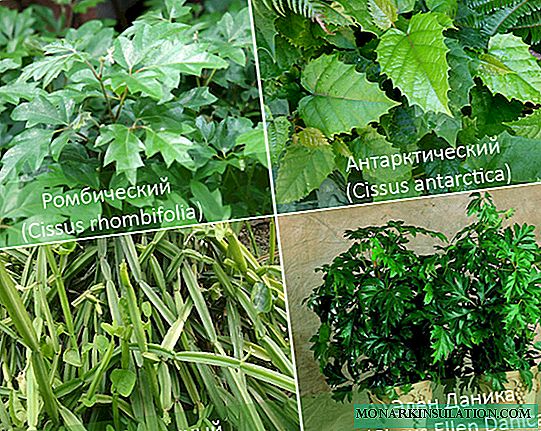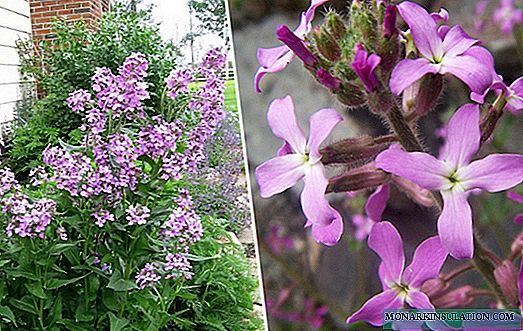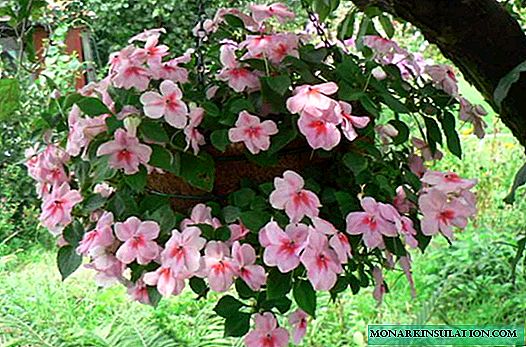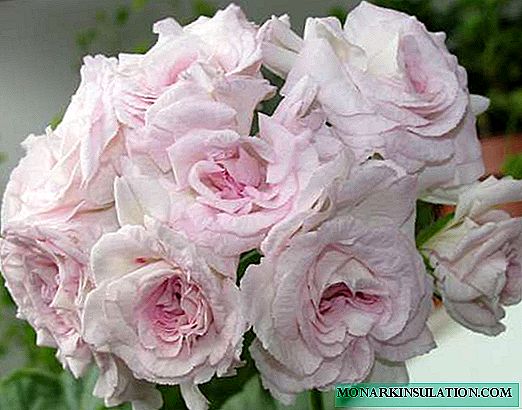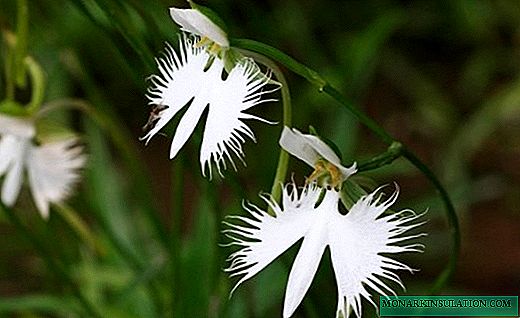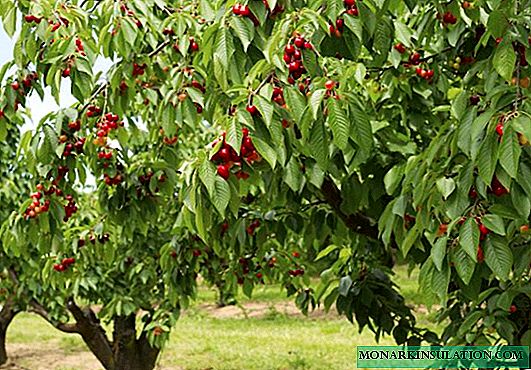
Cherry is the oldest form of cherry, known for eight thousand years BC. This heat-loving plant of the southern latitudes only in the last century thanks to the efforts of breeders began to advance into the cold regions. In order to grow this culture without problems and get a decent harvest, the gardener will have to work hard. And he also needs to learn the rules of landing and choosing a place with favorable conditions.
Sweet cherry planting dates
There are two options for the timing of planting cherries - spring and autumn. The first option is the most preferred and common, it is suitable for all regions of cultivation. The time for planting should be chosen in early spring, when sap flow has not yet begun and the buds have not swollen. Moreover, the snow should already be gone, and the earth should warm up to + 5-10 ° C. This time is good because nature begins to wake up and planted plants wake up with it. They immediately begin to take root and start to grow. The survival rate of seedlings at this time is maximum. And by the autumn, the sweet cherry will finally take root in a new place, get stronger, gain strength and be able to safely survive its first winter.
In the southern regions with warm winters and a long growing season, the option of autumn planting is possible. In this case, the time must be chosen so that before the onset of cold weather there are 3-4 weeks left, during which the seedling will have time to take root. This option has one advantage - in areas with dry and hot summers, seedlings planted in the spring have to deal with drought and heat, which is excluded during autumn planting.
Where to plant sweet cherry on the site
For planting cherries you will need a well-lit and ventilated place. At the same time, it should be protected from the cold northerly winds in the form of thick trees, walls of buildings or structures, fences. It is better to choose a small south or southwest slope on which water will not stagnate. Waterlogging and close occurrence of groundwater (less than 2.5 meters) is not allowed.
What soil does cherry love
Fertile loams are suitable for cherries grown in arid regions, and sandy loams are suitable in areas with sufficient or excessive moisture. In this case, the soil should have a loose, well-drained structure. The optimum level of acidity is pH 6.7-7.1, but on chernozems with a large amount of humus, plants can also tolerate carbonate (increased alkaline reaction) soil. In this case, a reaction up to pH 8.0 is permissible.
How to plant sweet cherry if groundwater is close
There is no economically viable way of growing sweet cherries in areas with a close occurrence of groundwater. On soaking soils, it is imperative to drain by installing drainage ditches that remove excess moisture from the site. Pleasure is expensive and time consuming.

Draining a site is an expensive undertaking.
In cases where the occurrence of groundwater is within 1-1.5 m, you can apply the landing of cherries on a hill. It is poured over the landing pit 0.5-1.2 meters high and 2-2.5 meters in diameter.
At what distance should the cherries be planted from each other?
The planting interval depends solely on the size of the crown. And it, in turn, depends on the type of sweet cherry and stock on which the vaccination was carried out. On average, the crown crown diameter is usually 2.5-4 meters. Based on the characteristics of the planted variety, the distance between the trees in the row is taken equal to the diameter of the crown, and the distance between the rows is increased by 1-1.5 meters. That is, with a crown diameter of 3 meters, the landing pattern is selected 3 x 4 meters.

Cherries are planted at a distance of three meters from each other
What trees can I plant cherries with?
It is best to group plants according to the principle - like with like. Cherry is preferably planted in a group with other cherries and cherries. Pome seeds - apple and pear - usually depress the cherries, so you should stay away from them. And also it is worth avoiding the neighborhood with sea buckthorn - in general, it is a bad neighbor for any crops. Apricot has a rather extensive and powerful root system, which will actively deal with the same root cherry system. Therefore, it is worth spreading their neighborhood by 5-6 meters. Plum and cherry plum will not harm the sweet cherry, but she herself will oppress them.
Where to plant self-fertile cherries
Self-infertile cherries require the presence of pollinating plants within a radius of 50-100 meters. As a rule, these should be cherries of other varieties, the flowering period of which coincides with the flowering period of the planted tree. In addition, according to some sources, a good pollinator for cherries is Lyubskaya cherry. This should be considered when planting cherries. If there are no such plants nearby, but you want to plant sweet cherries, and it’s self-fertile, then you will have to plant pollinating cherries at the same time.
How to plant sweet cherry
Planting cherries requires some preparation.
Preparing a planting pit for cherries in spring
Planting pit for cherries must be prepared at least 20-30 days before planting. If it is planned for spring, it is better to prepare a landing pit in the fall. For this:
- It is necessary to dig a hole with a depth of 50-60 centimeters and a diameter of 80-100 centimeters. On humus-poor soils, the pit volume is increased in order to introduce more nutrients into it when planting.

It is necessary to dig a hole with a depth of 50-60 centimeters and a diameter of 80-100 centimeters
- If the soil is heavy, clayey, then the depth of the pit needs to be increased to 80 centimeters and a drainage layer with a thickness of 10-20 centimeters should be laid at the bottom of it. Crushed stone, expanded clay, gravel, broken brick, etc. are used as drainage.

If the soil is heavy, clay, then at the bottom of the landing pit you need to lay a drainage layer with a thickness of 10-20 centimeters
- After this, the pit must be filled to the brim with a nutrient mixture consisting of equal parts of chernozem, peat, humus and coarse river sand. 30-40 grams of superphosphate and 0.5 liters of wood ash are added to each bucket of such a mixture.

The landing pit must be filled to the brim with a nutrient mixture
- For the winter, the pit is covered with moisture-proof materials (film, roofing material, slate, etc.) to prevent the washing out of nutrients by melt and rainwater.
Planting cherries in spring seedlings
The most common option for planting cherries is planting with seedlings. They are usually purchased in the fall, since at this time there is a large selection of high-quality planting material of various varieties. It is worth giving preference to seedlings of one or two years of age. Such ones better take root and take root, enter fruiting faster. The root system of the seedling should be well developed and have healthy fibrous roots without growths, nodes and cones. The trunk should be at least 10-15 mm in diameter, have a smooth bark without cracks and damage. Recently, cherry seedlings with a closed root system are increasingly being offered for sale. Their advantage is that such plants can be planted at any time from April to October.

Seedlings with a closed root system can be planted at any time during the season
How to keep cherry seedling before planting in spring
You can save seedlings purchased in the fall either in the cellar (basement) or buried in the ground. In the first case, you need to have a room with a constant air temperature from 0 to +5 ° C. Sapling roots are dipped in a mash of mullein and clay, and then placed in a humid environment (sand, sawdust, moss).
In the second case, you need to dig a hole in the garden with a depth of 20-30 centimeters, at the bottom of which a small layer of sand is poured. Seedlings are inclined in the pit and fill the roots with sand. It is watered and covered with earth almost completely, leaving only the top not covered. She is covered with spruce branches to prevent damage by hares.

Until spring, seedlings can be preserved by digging them in the garden
Step-by-step instructions for planting cherries
Now everything is ready for the successful planting of sweet cherries - a planting pit in the chosen place and a seedling of the desired variety, placed in storage. In early spring, with the onset of the optimal time, they begin to land:
- On the day of planting, they take out a seedling from the basement or prikop and examine it. If damaged or frozen roots are found, cut them with a pruner.
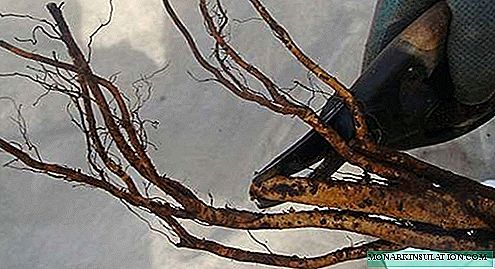
If damaged or frozen roots are found, cut them with pruning shears.
- Soak the roots for several hours in a solution of a growth stimulator (Epin, Heteroauxin, Kornevin).
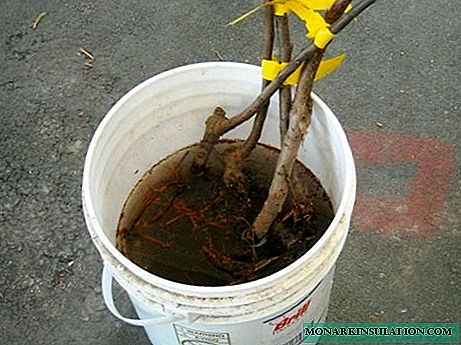
Soak the roots for several hours in a solution of growth stimulant
- Open the landing pit and make a hole in it according to the size of the root system of the seedling.
- A small knoll is formed in the center of the hole, and a wooden or metal stake is driven a little to the side of the center. Its height above the soil should be in the range of 80-120 centimeters. Two colas can be used to better fix the plant.
- The seedling is lowered into the hole, placing the root neck on the top of the mound, and straighten the roots on the slopes.
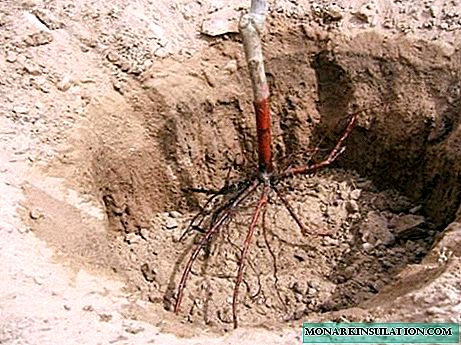
The seedling is lowered into the hole, placing the root neck on top of the mound, and straighten the roots on the slopes
- At this stage, it is better to use the help of a second person. One will hold the plant, and the second - to fill the hole with earth. This must be done in layers with the compaction of each layer. It is necessary to ensure that in the end the root neck of the seedling is at the level of the soil. To do this, it is convenient to use a rail or bar.

It is convenient to control the level of the root neck when planting cherries using a lath or bar
- The central conductor of the seedling is cut to a height of 60-80 centimeters, and the branches (if any) are shortened to 20-30 centimeters.
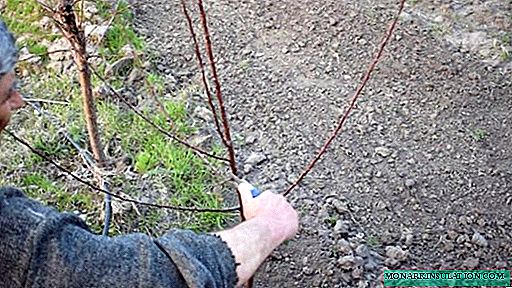
After planting, the seedling is cut
- They tie the barrel to the stake with elastic material in the form of an “eight” without crushing the bark. And also for these purposes, you can use special plastic clamps.
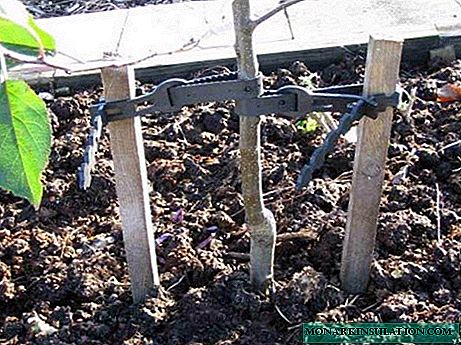
For garter seedlings, you can use plastic clamps
- A near-stem circle is formed by raking an earthen roller along the diameter of the landing pit.
- Abundantly water the plant to three times the absorption of moisture. This is necessary to ensure good contact of the soil with the roots and eliminate sinuses in the root zone.
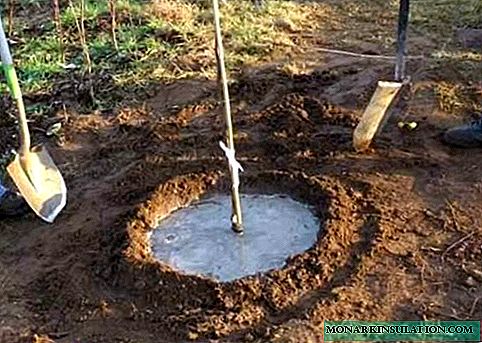
Water the plant abundantly up to three times the absorption of moisture
- The next day, the soil is loosened and mulched, using humus, compost, rotted sawdust, hay, etc.

After watering, the soil is loosened and mulched.
How to plant grafted cherries
Grafted cherries are planted according to the same rules as root crops. The only feature is that the vaccination site is sometimes too low. In this case, when planting, you need to ensure that it does not appear to be buried in the soil. It is advisable that the vaccination site is located above the ground by 5-7 centimeters. In regions with a high level of snow cover, it is better to purchase seedlings grafted at a height of 0.5-1.0 m.

It is advisable that the vaccination site is located at least 5-7 centimeters above ground level
How to plant sweet cherries in a container
Currently, seedlings of plants with a closed root system (ZKS) are increasingly sold. Usually they are grown in containers or buckets and sold with them. This method has obvious advantages:
- When transplanting such a seedling, the root system is not injured and its survival rate is 100%.
- Seedlings with ZKS can be 3–4 years old when transplanted, which shortens the time for cherries to bear fruit from the moment of planting.
- You can plant such plants at any time from early spring to autumn.
Planting pit for cherries with ZKS is prepared according to the same rules as for ordinary seedlings, planting rules also do not change. Features of the landing are as follows:
- A knoll is not formed in the planting pit, because the seedling is transplanted from the container by transshipment with a lump of earth.
- Also, such a plant does not need a stake for garter, since a large lump of earth on the roots reliably holds the cherry.
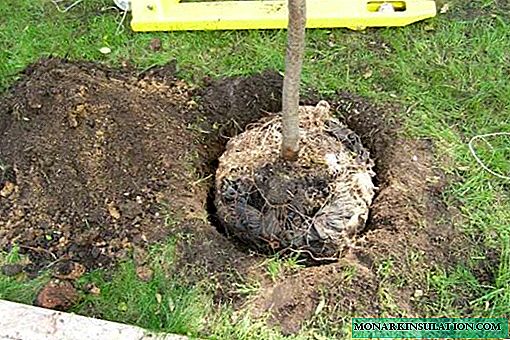
A large lump of earth on the roots reliably holds the cherry
Video: planting cherries
How to plant sweet cherry with a bone
Of course, cherries can be grown from seed. Question: why? It is known that with this method of growing varietal features of the original are not preserved. No matter how tasty and large the berry is, the seed of which was used for growing, the result is likely to be one. After long labors, a wild game with small berries of mediocre taste will grow. Yes, such a plant will have endurance, unpretentious care, frost resistance, immunity to diseases and pests. But it will be possible to use it only as a stock for the grafting of varietal cherries or for decorative planting of greenery. Given this, we describe the process of planting cherries with a stone briefly:
- From the cherries growing in the area, they collect the right amount (with a margin) of seeds from fully ripened berries.
- The bones are freed from the pulp, washed and dried.

The bones are freed from the pulp, washed and dried
- Placed in a paper bag and stored until December at room temperature.
- In December, the bones are soaked for three to four days in water, changing it daily.
- They are placed in a container with a moist substrate (sand, sawdust, moss-sphagnum).
- The container is set in the refrigerator for three months to stratify the seeds.
- In early spring, the container is taken outside and covered with snow.
- After the shells crack and begin to germinate, they are planted in individual pots or trays to a depth of 1.5-2 centimeters.

After the shells crack and begin to sprout, they are planted in individual pots
- Shoots usually appear after 25-30 days. When they reach a height of 10-15 centimeters, they are dived into larger containers.
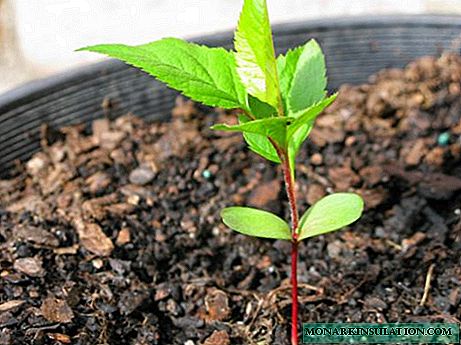
When the seedlings reach a height of 10-15 centimeters, they are dived into larger containers
- With regular moistening and loosening by the fall, they will grow to 25-30 centimeters.
- After this, at least a month before the onset of frost, the seedlings obtained are planted in a permanent place, following the rules described above. At the same time, care must be taken to protect plants from frost and rodents, equipping shelters for them from plastic bottles with a cut bottom.

It is necessary to take care of protecting plants from frost and rodents by equipping shelters for them from plastic bottles with a cut bottom
How to plant sweet cherry in spring with cuttings
In order to plant the sweet cherry cuttings, it must first be rooted. The rules for planting rooted cuttings are the same as for planting an ordinary seedling.
Rooting cuttings of cherries
As a rule, cherries are propagated by green cuttings. This process is simple, but somewhat painstaking. It consists of the following:
- Harvesting cuttings. The best time for this comes when the young shoots reach a large length and begin to lignify, but they themselves are still quite flexible. In central Russia, this falls on June 10-30. So:
- Early in the morning, while it’s cool, they choose lateral shoots of medium growth, located on the young growths of last year and growing in a well-lit part of the crown. Cut out their secateurs.
- From these branches, cuttings of 8-10 centimeters in length are cut. Each of them should have 3-4 kidneys and a leaf. In this case, the lower section should be one to two centimeters from the first kidney.
- One or two lower sheets are cut out completely, and the upper ones are cut off by 50-60% to reduce the evaporation area.

One or two lower sheets are cut out completely, and the upper ones are cut off by 50-60% to reduce the evaporation area
- Harvested cuttings are placed with the lower end into the solution of the root stimulant (Kornevin, Heteroauxin) to a depth of 2.5-3 centimeters. In this solution, cuttings should stand until evening.
- To root the cuttings, you need to prepare a container with nutrient soil. First, water-absorbing sheet earth is poured onto the bottom with a layer of 10-12 centimeters. A substrate from a peat-sand mixture is poured on top with a layer of 3-5 centimeters.
- In the evening, cuttings are removed from the solution and stuck them into the prepared soil to a depth of 3-4 centimeters so that the lower kidney is located in the substrate. The distance between the cuttings in a row should be within 5-7 centimeters, and between rows - 8-12 centimeters.
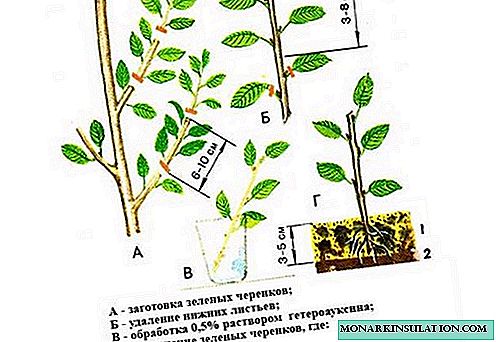
Cuttings for rooting are cut from the side shoots located on the young growths of last year
- Moisturize the soil from a spray bottle.
- The container is placed in a well-lit greenhouse, in which a high level of humidity should be maintained. The best rooting temperature is 23-30 ° C.

The container with cuttings is placed in a well-lit greenhouse, in which a high level of humidity should be maintained
- Further care consists in daily airing and double watering from the sprayer. And also, if necessary, the soil must be carefully loosened.
- After about a month, the plants will already have good roots and should be planted. You can immediately drop off to a permanent place, but it is better to transplant into containers or buckets, and postpone the landing until spring. In this case, such seedlings will need to be placed in the greenhouse for the winter or equipped with temporary shelter for them from frost.
Video: how to root green cuttings correctly
Planting cherries, depending on the area of cultivation
Planting rules and requirements for the location of the tree are independent of the growing area. They are standard and described above. The difference exists only in the varieties and methods of cultivation used, in particular in the care and formation.
In Belarus
The continental climate of Belarus is excellent for growing winter-hardy cherries. Among them:
- Gascinets;
- Iput;
- North;
- Folk;
- Syubarovskaya and others
The dates for sweet cherry planting in Belarus are early spring.
In Ukraine
Cherries, like cherries, are massively grown throughout Ukraine, especially in its southern regions. A large number of zoned varieties are bred here (mainly at the Melitopol experimental gardening station):
- Melitopol black;
- Melitopol early;
- Valery Chkalov;
- Mascot;
- Wondrous;
- Space and many others.
Landing is carried out both in spring and autumn (in the southern regions) according to standard rules.
Sweet cherry planting in Central Russia, including the Moscow Region
Winter-hardy varieties from early to mid-late ripening are suitable for these areas. For the most part, they are the fruits of breeding of the All-Russian Research Institute of Lupine (Bryansk) and the All-Russian Selection and Technology Institute of Gardening and Nursery (Moscow), as well as some Belarusian and Ukrainian varieties. Planting cherries here should only be in early spring.
In Volgograd
Only two varieties of cherries were noted in the State Register for this region - Early pink, medium-term ripening and Dyber black, medium-late ripening. But gardeners of Volgograd and the region do not look into the State Register and successfully grow many of its other varieties:
- Valeria;
- Homestead;
- Donetsk beauty;
- Rossoshanskaya;
- Yaroslavna and others
The term for planting cherries in Volgograd is early spring.
In the Leningrad region
Bred for this region, the variety Leningradskaya black was never included in the State Register. There are no other varieties in it for the North-West. Gardeners of the Leningrad region judging by the reviews grow such varieties:
- Fatezh;
- Chermashnaya;
- Iput;
- Jealous.
Friends, help with advice. What types of cherries will grow and bear fruit in the Leningrad region? Preferably different 2-3 grades. Eye fell on the Leningrad black and Bryansk pink.
Martini SPb, Cottage in Apraksin, Leningrad Region
//dacha.wcb.ru/index.php?showtopic=55264
Quote (Klimych) Leningrad black due to the name should at least grow normally.
Klimych, Cottage in Apraksin, Leningrad region
//dacha.wcb.ru/index.php?showtopic=55264
Klimich, we are neighbors! And what do you grow from trees and shrubs in general? Maybe there’s no point and wasting power on something?
Martini SPb, Cottage in Apraksin, Leningrad Region
//dacha.wcb.ru/index.php?showtopic=55264
Fatezh, Chermashnaya, Iput, Revna.
NadezhdaS, Cottage in Flax. region south
//dacha.wcb.ru/index.php?showtopic=55264
In the Urals
The climate of the Urals is characterized by instability of weather conditions and sharp temperature drops. In such conditions, the cultivation of a southern, thermophilic crop, which is sweet cherry, is fraught with considerable difficulties. But there is experience in the successful cultivation of some winter-hardy varieties, zoned in the Central region. The most promising varieties were Iput and Northern breeding of the Belarusian Institute of Fruit Growing. In 2012, gardener-expert Vladimir Pitelin wrote about the abundant harvest of varieties Fatezh (selection of the Moscow Institute of Fruit Growing) and 2-7-37 in the conditions of the Southern Urals. According to him, planting cherries in the Urals does not differ from planting in the middle lane. In this case, all the rules described above apply. Only they need to be carried out more carefully - the Ural climate does not forgive mistakes. And he also recommends the use of seedlings on a dwarf rootstock VSP-2 for the cultivation of cherries in both standard and shale form.
Video: cherries in the gardens of the South Urals
In Siberia
In Siberia, there are also enthusiasts who are experiencing cherries in local conditions. As a rule, these are the same varieties as those grown in the Southern Urals. Dwarf cherries winter especially well in places where the snow cover is of considerable thickness and covers the trees completely. Shaft formation in Siberia is also successfully used. Landing rules are standard.

Strawberry cherry formation is used in the Urals and Siberia
Spring cherry transplant
A sweet cherry transplant is an undesirable event for her. Moreover, the older the plant, the more harmful the consequences may be and the higher the risk of non-survival. This is due to the inevitable trauma of the root system, as well as the loss of most of it in the event of an old tree transplant.
When can I transplant sweet cherries in spring or autumn
Most gardeners recommend doing this in early spring, especially in areas with cold climates. This is explained by the fact that, transplanted in the fall, the tree will not have time to take root well and will leave in the winter weakened. In places with mild winters and hot summers, it is recommended to transplant in the autumn, since the plants here are more likely to dry in the summer than to freeze in the winter. In any case, when preparing for a transplant, it is better to rely on the experience of local gardeners and specialists.
How to transplant young cherries, including a three-year-old
Transplanting young cherries is not much different from planting a seedling. The main difference is that in order to transplant a tree, you still need to dig it from the ground correctly.
Step-by-step instructions for transplanting young cherries
In this instruction, we describe the process of spring planting of a transplanted tree:
- First of all, you need to dig a young tree from the ground. This is done in autumn, since in spring weather conditions may not allow you to dig up the plant before the onset of sap flow. For this:
- If the soil is dry, then the day before digging it should be watered so that it softens.
- Around the tree outline a circle with a diameter equal to the estimated diameter of the root system. You can do this with a twine tied to the trunk and some stick.
- With a shovel, dig a groove around the plant, focusing on the drawn circle.

For transplantation, dig a groove around the plant, focusing on the drawn circle
- Extract the plant from the pit, trying not to destroy the earthen lump on the roots.
- They dig it in the garden for winter storage.
- The second step - preparation of the landing pit - is also carried out in the fall according to the previously described algorithm.
- In early spring, they take a seedling from prikop and plant it in compliance with the rules set out above.
- Cut the crown, leaving no more than five skeletal branches, which are shortened by 30%. This is done so that the plant does not waste energy on the growth of shoots, but first of all directed them to the development of the root system. For the same purpose, all flowers are removed, not allowing fruiting in the first year after transplantation.
How to transplant an adult cherry tree
If necessary, an adult tree can be transplanted, although experts believe that cherries aged over seven years will not tolerate this. In this case, you can try an interesting method, which is as follows:
- At the end of September, a circle is marked around the tree, as is the case with the young tree. Its diameter should be such as to capture as many roots as possible, but at the same time, the weight of the extracted part was within reasonable limits.
- A sharp shovel with a flat blade cuts the roots on half of the marked circle.
- They dig a trench along this half of the circumference with a depth on the bayonet of a shovel.
- In the lower part of the trench, the roots are cut even deeper, onto the bayonet of the shovel.
- They fall asleep in a trench and watered with water.
- The tree continues to feed due to the second half of the roots left untouched. In the first half at this time, new roots will begin to form, which will fill the internal space of the root system.
- After 3-4 weeks, the same procedure is carried out with the second half of the roots. They are cut, dug, once again cut, bury. Abundantly watered for another two weeks and leave the tree until spring.
- At the same time, it is worth taking care of the landing pit for the transplanted plant.
- In early spring, as the weather permits, the plant is dug out of the ground with a clod of young roots and transplanted to a new place.
Unfortunately, there are no illustrations of this method, but there is a great video worth watching.
Video: a new method of transplanting adult trees
Subsequent transplantation of cherries, including how to transplant an old tree
Subsequent cherry transplantation is likely to be a futile exercise. It is unlikely that the tree will transfer this procedure again. Therefore, the choice of a place for landing should be approached responsibly so as not to have problems in the future. Theoretically, the possibility of transplantation remains. But you need to do this with a large lump of land, using special equipment for this - an excavator, a crane, a truck for transportation. And even if you do not take into account significant material costs, the success of the event is not guaranteed. Since this technique will not be able to drive to any place.

It is unlikely that the gardener will use special equipment to transplant old cherries
I have never taken root in a normal tree. Three times replanted, more precisely, at a time replanted three cherries for 7 years each. Although, maybe, of course, I screwed up something.
mironenkovitalick
//www.stroimdom.com.ua/forum/showthread.php?t=214461
Sweet cherry is very moody in terms of transplantation in adulthood (and not only transplants). The friend also did not survive the tree.
Vladdi, Kiev
//www.stroimdom.com.ua/forum/showthread.php?t=214461
The rules for planting, breeding and transplanting cherries are actually not so complicated that the novice gardener could not understand them. With due diligence and the presence of favorable conditions for culture, the result of the labor invested will certainly not upset.





















